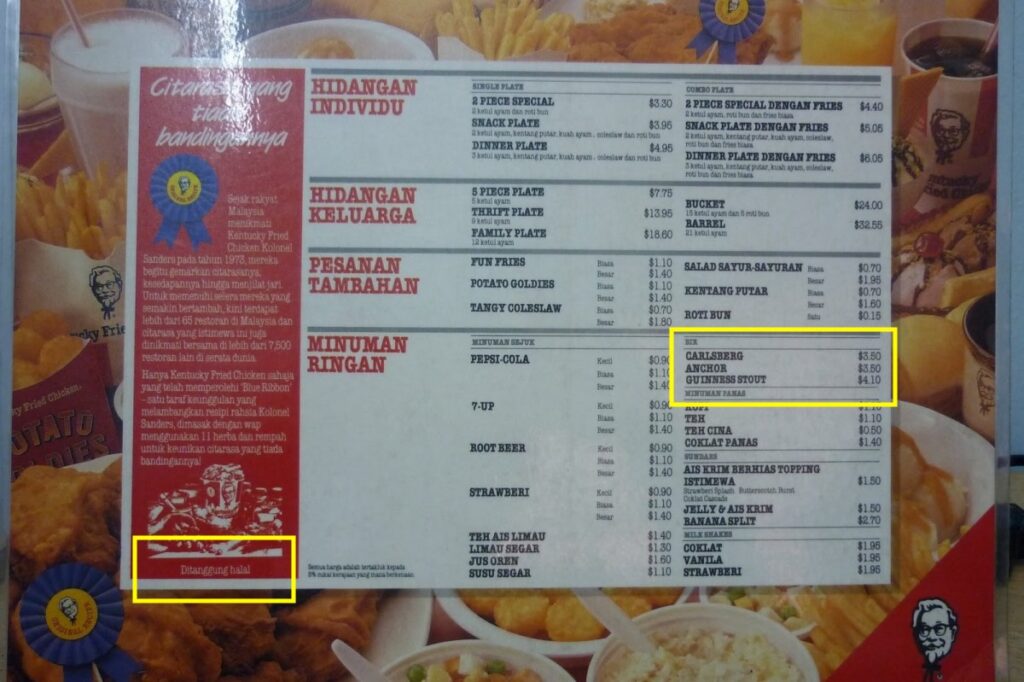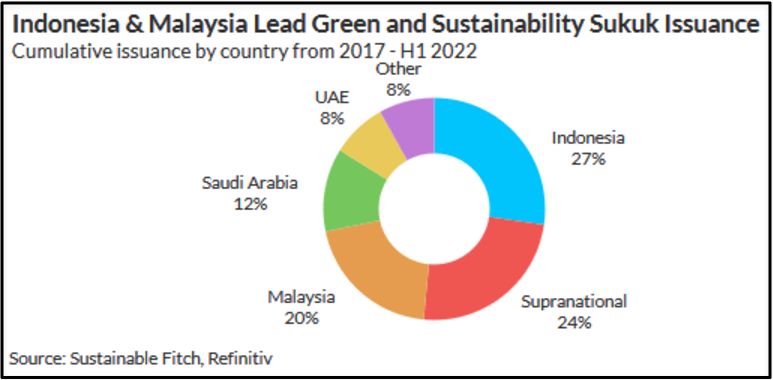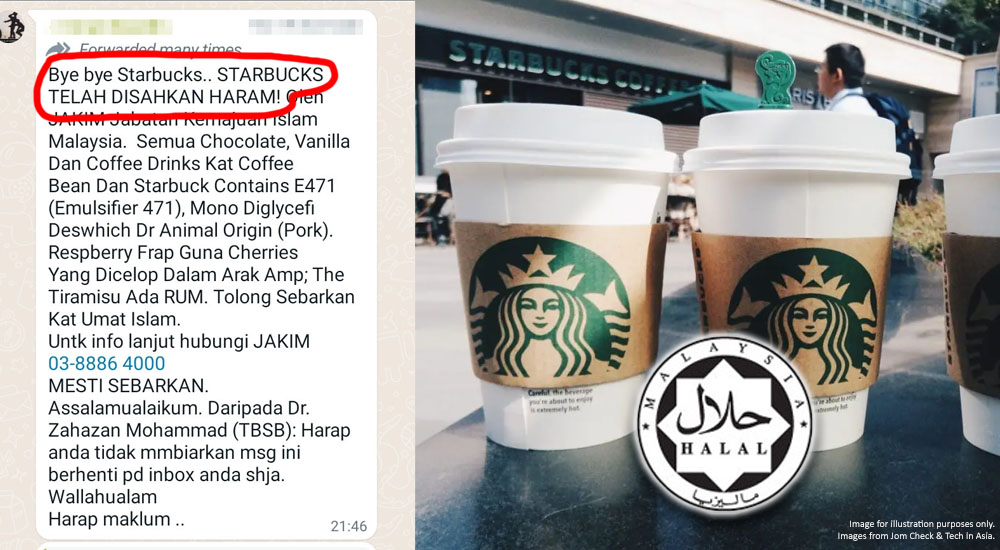This tiny Malaysian logo is so powerful, China faked it

- 3.5KShares
- Facebook3.3K
- Twitter19
- LinkedIn19
- Email11
- WhatsApp106
Before we tell you, let’s play a game. Try guessing if it’s the SIRIM, Buatan Malaysia, MeSTI, or Halal logo:

If you answered D, then congratulations you get 100 pahala points
In 2013, companies in China admitted to putting fake JAKIM halal logos on their products. But hold on to your panic, these weren’t for the Malaysian market – these were actually for the domestic China Muslim market. So now you might be wondering………. China got no halal logo meh?
It’s not to say that China doesn’t have a halal logo and certification body of their own – they’ve got at least six. But if naughty companies want to scam China Muslims with foreign halal logos, why not use one from a more ternama Muslim country like say… Saudi Arabia, the literal birthplace of Islam?

Well, it’s because JAKIM’s standards are the leading halal standards among Islamic countries. In fact, our little Halal logo is recognized worldwide and completely trusted by the OIC (Organization of Islamic Cooperation) countries.
If you’ve asked yourself why we put so much work into our halal standards, you’d likely have arrived at the obvious reason. It’s because Malaysia is a Muslim-majority country so Muslims should be able to eat or use something tanpa was-was.
While that’s true, what if we tell you this is actually only one out of 7.7 trillion other reasons?
The global halal economy is worth an estimated USD7.7 trillion in 2025

A good indicator of our economic priorities lies in the national budget. If you look at the Belanjawan 2025 speech, you’ll notice there’s one section dedicated to Islamic finance and one to halal industry development.

There’s a reason for this. The halal industry is expected to contribute 8.1% to our GDP in 2025, and it’s actually very achievable.
In 2021, the halal economy was worth USD5.7 trillion and projected to grow to USD7.7 trillion in 2025. If you’re wondering how Muslims can eat 7.7 trillion dollars worth of food, then you’d be mistaken. The bulk of this money is actually in Islamic (shariah-compliant) financial services.
The halal economy is more than just food and – guess what? Malaysia is in the lead for a lot of them. According to the 2023/24 Global Islamic Economy Indicator, Malaysia ranks:
- First in Islamic Finance, Halal Food, Media & Recreation
- Second in Modest Fashion
- Third in Pharmaceuticals
- Fifth in Tourism
In fact, we took the top overall spot this year; ahead of Saudi Arabia, Indonesia, and the UAE. Don’t feel too proud though. This is our 10th year in the top spot, so we actually maintain result only.

On a serious note, this achievement actually translates into real economic benefit. The halal industry contributed RM108.5 billion (or 7.5%) to our GDP in 2022, with more than half of that coming from exports.
In fact, we’re banking on Malaysia’s halal industry to grow more than 4 times (RM500.34 billion) by 2030.
But how did Malaysia’s halal logo get so good?

This might seem counter-intuitive, but one reason our halal logo is so trusted is because we have only one. Every attempt to introduce a second halal logo or a variation has been met with a solid, resounding “no”. In fact, there’s even a law under the Trade Descriptions Act 2011 to prevent this from happening.
To understand why keeping to one logo so important, we’ll have to look back into the history of halal legislation in Malaysia.
Halal as a law (halaw?) isn’t as old as you’d think. Before the times of JAKIM logos and “ditanggung halal” signage, Muslims just had to rely on good ol’ common sense – kalau ada itu pork, jangan angkat itu fork.
It wasn’t until 1974 that the Islamic Affairs Division in the Prime Ministers Office became the first body to issue official halal documents. Even then, it mostly applied to walk-in eateries and the criteria was based on cleanliness; which is why older readers may remember the roaring 1980’s when restaurants like KFC served beer yet was “ditanggung halal”.

The birth of our modern halal era came in 1997, when the Islamic Affairs Division became the standalone department we know as JAKIM. This was the point where everything went into full swing. Laws, procedures, and guidelines were put in place and improved on over the years to define what halal means in the modern era.
They essentially had to figure out how a chicken from a commercial farm in Johor becomes a nugget on your plate in a Penang restaurant without violating the principles of halal anywhere in that process. And it’s not just religious, the cleanliness criteria from the 70’s remains a core basis of halal compliance.
In Belanjawan 2025, it seems like the focus is to further improve the process. JAKIM is seeing another 100 halal auditors added to their ranks, which would shorten the waiting times for certification.
Most people assume [JAKIM’s] audits are only for religious reasons, like making sure there’s no pork, but it’s actually very similar to ISO and HACCP standards for food quality. They will pick up on cleanliness, manufacturing practices, delivery to the supermarkets – even pointing out places where they see cobwebs!
– En. Fazly, Victoria Crest Halal Compliance Committee, quoted from a previous Cilisos article.
All this behind-the-scenes work is condensed into one symbol:

So if you think of it in terms of branding, this is our halal version of the Apple logo or the Nike Swoosh – representing quality, aspiration, and lifestyle choices in one simple logo.
Malaysia is also a pioneer in making things halal
You might remember Rayani Air, the halal airline that failed to take off, or the halal web browser SalamWeb.

These ventures were so over-the-top with their halalness that it’s easy to go hahaha(lal) when they failed to live up to the hype. However, it’s also arguable that these were necessary setbacks – you don’t know what works until you’ve tried.
As Tomas ibn Edi once said:
“I have not failed. I have just found 10,000 things that are not ready to be halal yet.”
– yes this is a halal Thomas Edison joke
But let’s talk about successes.
Earlier in the article, we mentioned that the bulk of the halal economy is in Islamic Finance. In 2020, Malaysia ranked third in Islamic Finance assets, at USD620 billion or 18% of total assets. We are also the world’s largest sukuk (Syariah-compliant bond) market, holding 42% of the world’s outstanding sukuk. Fun fact: we issued the world’s first sovereign US Dollar Sustainability Sukuk. This financial certificate isn’t only Syariah-compliant but is exclusively used to support social and green projects.

The plan in Belanjawan 2025 is to further push the limits. While we’ve done really well in Syariah-compliant financial products, they’re basically an Islamic copy of conventional banking. This is why RM100 million will be allocated as matching funds to drive new innovations that aren’t just copies. An example is an initiative based on Musharakah, which involves shared risk and fair profit.
Finance aside, we also came up with the world’s first halal pharmaceutical standard, which has opened the avenue to manufacture and export halal medicines and healthcare products. For instance, Duopharma Biotech became the world’s first company to receive halal certification for an oncology product to treat breast cancer.
These are just a few recent examples of Malaysia’s pioneer status in the halal economy. If we were to go back in history, we were also early to the halal cosmetic game with Safi and Zaitun in the 1980’s. All this to say, we aren’t stopping when it comes to halal.
View this post on Instagram
Long-term plans like the Halal Industry Masterplan 2030 and the National Halal Policy 2025 – 2035 blueprint will ensure that we get a bigger slice of the dijamin halal pie. And it’s something that doesn’t only benefit Muslims. For one, halal options expand the range of existing products to offer more choices. Second, the growing halal economy opens the door to new markets for local companies and entrepreneurs.
So if you’re a businessman with a halal business plan, Belanjawan 2025 is the best gauge for the government’s direction, as well as funding and support that you can get.
Malaysia wants to be a halal support line for other countries

Let’s bring things back to full circle with China. Chinese companies are apparently eyeing Malaysia as a benchmark for halal, with some looking into opening manufacturing facilities in Malaysia to meet JAKIM’s standards and (properly) obtain our halal logo.
It’s not just limited to China. Non-Muslim countries are starting to eye halal as an up-and-coming market, with PM Anwar sharing that Vietnam and Laos asked for Malaysia’s help to start a halal network in their respective countries.
“…during my official visit to Vietnam and Laos recently, during bilateral discussions I was asked in detail about halal certification and the halal industry ecosystem, and they requested Malaysia’s assistance in training and opening the path to the establishment of a halal product network in their countries.”
-PM Anwar Ibrahim, as quoted by The Star. Slightly edited by CILISOS for length
In a broader perspective, what all of this demonstrates is that halal in Malaysia is as much economically as it is religiously significant. So when we buy something with that little 8-pointed star thingy (Rub el Hizb) inside a circle, “safe for Malaysian Muslims” is just one side of the dinar. There’s a whole other side that involves GDP, international trade, and branding on an international scale.
And there you have it, a look at….

- 3.5KShares
- Facebook3.3K
- Twitter19
- LinkedIn19
- Email11
- WhatsApp106



